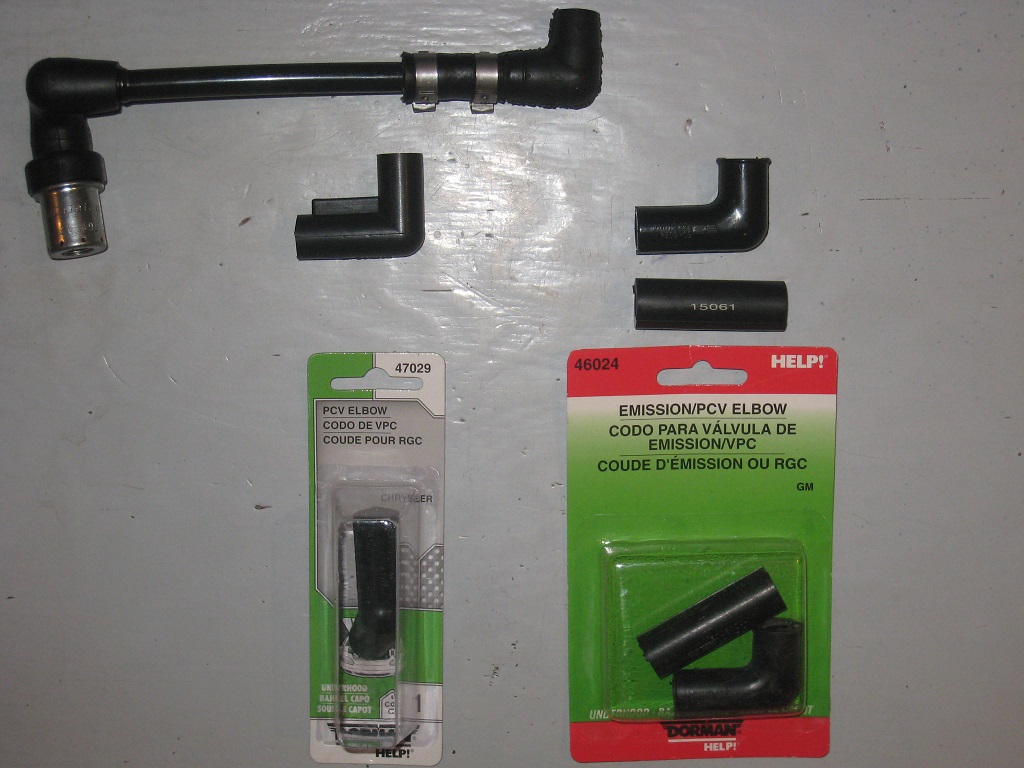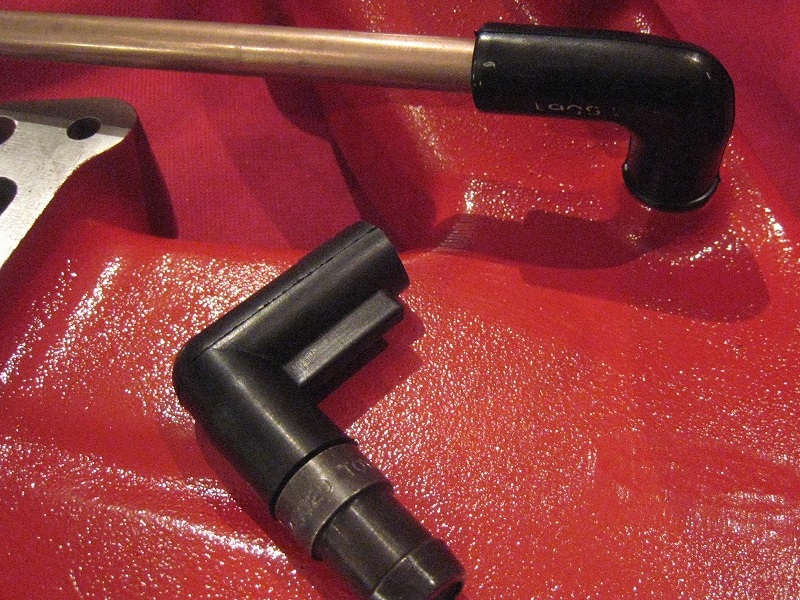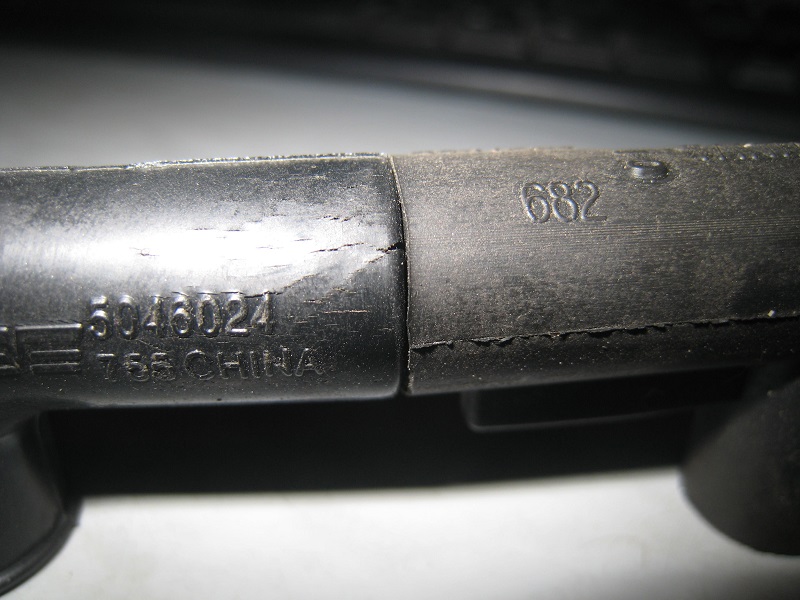
 
     |
| PCV valve for boosted engines (Page 3/4) |

|
pmbrunelle
|
MAY 04, 11:22 PM
|
|
I tried two elbows:
Dorman 46024
Dorman 47029
At the top is a modified (just shortened, the ends are original) stock Fiero 2.8 PCV assembly, for reference.

Either elbow works in either position (intake manifold or PCV valve).

The elbows also fit well over a 3/8" OD cupro-nickel brake line. A plain deburred end results in a tight fit with either elbow. No clamp would be necessary.

I'm not sure which elbow is preferable.
The Dorman 46024 is made of a stiffer rubber.
The Dorman 47029 is more supple; it stretches a lot more when attempting to pull it off a fitting. Could this result in tearing when I go to service/disassemble the elbow down the road?
I will read online reviews to see what people have to say regarding these parts' respective reliabilities.
|
|

|
pmbrunelle
|
MAY 04, 11:57 PM
|
|
The Dorman 46001 may also be a candidate to be evaluated.
EDIT:
The Dorman 46024 has awful reviews on amazon. Splitting after weeks or months.
47029 and 46001 don't have much data. I guess no reviews is better than bad reviews?
I am planning on tossing all three of these elbows into the valley of my daily driver's Vulcan 3.0.
After 2 months, hopefully one of them will still be serviceable...[This message has been edited by pmbrunelle (edited 05-05-2018).]
|
|

|
pmbrunelle
|
JUL 19, 08:52 PM
|
|
To follow up on this:
I placed these two elbows on the engine of my daily-driver Ford Ranger. Both elbows were slipped onto a piece of 3/8" OD tube.
Dorman 46024
Dorman 47029
After 4 months of daily driving with the Ford, here is the result:

The elbow on the left was cracked. The elbow on the right (Dorman 47029) looked fine, so I chose to use it on my Fiero build.
I have two summers and about 12000 km on my Fiero since the rebuild, and the elbow has been holding up fine.
I recommend the Dorman 47029.[This message has been edited by pmbrunelle (edited 07-19-2021).]
|
|

|
Dennis LaGrua
|
JUL 19, 09:47 PM
|
|
|
I ran a turbo for a few years and had the stock Fiero PCV valve. It is designed to work on vacuum and its seems to block pressure and pass vacuum. What ever it did, the boost came up fine and there were no problems. The breather seemed to eliminate any positive crankcase pressure that will occur in boost mode only. An engine with a turbo or supercharger only runs in boost mode for maybe 10 seconds at a time, if that. No ill effects were seen on my engine. ------------------
" THE BLACK PARALYZER" -87GT 3800SC Series III engine, custom ZZP /Frozen Boost Intercooler setup, 3.4" Pulley, Northstar TB, LS1 MAF, 3" Spintech/Hedman Exhaust, P-log Manifold, Autolite 104's, MSD wires, Custom CAI, 4T65eHD w. custom axles, Champion Radiator, S10 Brake Booster, HP Tuners VCM Suite.
"THE COLUSSUS"
87GT - ALL OUT 3.4L Turbocharged engine, Garrett Hybrid Turbo, MSD ign., modified TH125H
" ON THE LOOSE WITHOUT THE JUICE "
|
|

|
zkhennings
|
JUL 20, 01:32 PM
|
|
Late to the party but was going to make a new post for my question, but here seems as good a place as any.
I plan to run a PCV system on an NA motor (LZ9) with both valve covers feeding a catch can and then a breather line going to right before the throttle body. This would normally be the fresh air port for a stock setup, but also allows venting when the PCV is closed. I plan to use no PCV valve in my setup since I am not going to supply the system with any strong manifold vacuum.
Any issues with this setup or suggestions? From what research I have done this should be sufficient, but I do not know if I will be missing out on power from applying vacuum to the crankcase in a stock setup. Though it seems to not be true vacuum since there is a fresh air inlet on one valve cover in a stock setup. I do not want to run any breather filters as they seem to get gunked up quickly and start leaking at seals from the inevitable pressure build up. Catch can will be large for maximum oil extraction.
Thoughts?
|
|

|
thesameguy
|
JUL 20, 05:16 PM
|
|
I think you don't want to do it that way. The more efficient PCV approach is to have a vacuum port and a fresh air port, so that the vacuum side draws fresh air though the crankcase and back into the intake. So in your example, you would want one valve cover (after your MAF, if equipped) ahead of the throttle body for fresh air, and then a valve-equipped valve cover behind the throttle body for max vacuum.\
FWIW, proper PCV can help make power... keeping the crankcase under vacuum means that pistons aren't also pumping air around. On boosted motors, which have potential for significant blowby, PCV is critical.[This message has been edited by thesameguy (edited 07-20-2021).]
|
|

|
pmbrunelle
|
JUL 20, 09:11 PM
|
|
| quote | Originally posted by thesameguy:
I think you don't want to do it that way. The more efficient PCV approach is to have a vacuum port and a fresh air port, so that the vacuum side draws fresh air though the crankcase and back into the intake. So in your example, you would want one valve cover (after your MAF, if equipped) ahead of the throttle body for fresh air, and then a valve-equipped valve cover behind the throttle body for max vacuum.\
|
|
That's pretty much a description of PCV on most factory cars since the 60s.
What reasons motivate you to deviate from the standard configuration, zkhennings?
| quote | Originally posted by thesameguy:
FWIW, proper PCV can help make power... keeping the crankcase under vacuum means that pistons aren't also pumping air around. On boosted motors, which have potential for significant blowby, PCV is critical.
|
|
Unless you have a fancy setup like ericjon262, normal PCV doesn't keep the crankcase under vacuum at WOT, because there is no manifold vacuum.
|
|

|
thesameguy
|
JUL 20, 09:42 PM
|
|
There is no manifold vacuum at WOT, that doesn't mean there is no vacuum anywhere. For example, on my Saab and my XR4Ti the suction for the PCV is on the inlet side of the turbo. There is sufficient vacuum there for proper PCV function.  [This message has been edited by thesameguy (edited 07-20-2021).]
|
|

|
zkhennings
|
JUL 21, 12:01 PM
|
|
The stock setup does not use a normal PCV valve, it is a solenoid controlled by the ECM normally and I will be running Microsquirt. I could use another factory PCV valve (which is why I was looking at this thread originally) but I do not really see the benefit of putting the PCV system under vacuum at idle, and it's not true vacuum regardless because there is a fresh air source.
I do not necessarily want to put the system under true vacuum as I have seen that that can lead to sucking dirt in from around the various gaskets in the motor, it is great for a racecar but not necessarily a street car, even though it makes more power.
Since at WOT when the most blow by is created the intake is barely under vacuum, and in a boosted car the PCV would seal and it would just be evacuating to a pre-boost intake location, then I don't really see how having a PCV valve helps improve performance.
Seems like most people are successful with having breather filters on the valve covers or on their catch can, with the caveat that they get easily clogged so you have to check and clean them often.
Therefore I have come to the solution that I will vent both valve covers to a catch can that will have a line going to the intake pre-throttle body. The moving air should have a slight pressure drop for a light suction action, and it is no different in performance to a factory setup at WOT from my understanding. It will not be pulling vacuum at idle like the factory setup would, but it still can vent freely and out of both valve covers instead of just one of them.
If I was going to incorporate a PCV valve I would possibly need 2 catch cans if I really want to keep oil out of the intake because when the PCV closes, the venting is reverted and it vents through the fresh air inlet, so I would need filtration of some kind on that side as well.
The only information I have that would bias me towards including a PCV is that without the crankcase getting refreshed with clean air, it can cause acidic oil buildup from oil vapors condensing in the motor. I have not seen this actually happen to anyone though in my research. If there is any benefits of the PCV system I am unaware of I would appreciate that input.
It would not be challenging to incorporate a PCV valve, I just would like to keep dirty octane reducing oil out of the intake.
I could also go with the exhaust based evacuation system, though I would provide the motor with a fresh air source to prevent sucking dirt through seals. But since simple breather filters seem to work for most people who keep them clean, I think the simplest solution would be the original one I proposed with 2 vent lines going to a catch can which then goes to the intake pre-throttle body.
|
|

|
pmbrunelle
|
JUL 21, 12:56 PM
|
|
The idea of POSITIVE crankcase ventilation is that you have a vacuum source on one valve cover, a fresh air source on the other, and filtered air is constantly (well, most of the time when you're not at WOT) flowing through the engine, keeping the oil and crankcase clean.
Due to the fresh air vent, you don't have an actual vacuum in the crankcase (because air spills in from the fresh air vent). It wouldn't make sense to have no fresh air vent, because then the PCV would be sucking from a closed chamber, and there would be no constant airflow.
The idea of breathers connected together and going towards the intake tract allows the crankcase to relieve its pressure, but it does not provide constant air circulation. Early Mustangs had road draft tubes, and I did read on a forum about one guy who changed over to PCV, and he noticed that his oil was no longer black when he did his oil changes.
With a normal PCV setup, if you are concerned about oil being sucked into the intake manifold (though the PCV valve) potentially reducing the octane, well that should only happen at part-throttle when the octane requirement is low. At WOT, when you need high octane, there is no vacuum, so there shouldn't be any oil sucked through the PCV valve.
On my Fiero, I have the Supra PCV valve between the intake manifold and a valve cover, but the fresh air inlet (on the opposing valve cover) has its own dedicated K&N breather filter. It did drip oil sometimes, but I installed a sock to prevent the dripping:
https://allstarperformance....ather-sock-all36208/
I've never needed to clean the sock yet; it has not yet become saturated with oil.
It would have added more complexity to route the fresh air inlet back to the air filter canister, and I didn't want oil fumes to be routed there at WOT... in large part because I didn't want the blow-off valve to open and blow a bunch of oily mist throughout the engine bay.
The exhaust-based system with a fresh air vent at least accomplishes the goal of circulating fresh air (sometimes) through the crankcase.
You can implement your breather plan without positive ventilation, but you're basically going back to pre-60s tech.
|
|
    
  |
|















